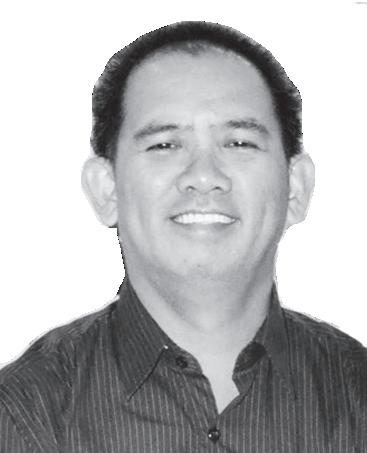
7 minute read
BSP-supervised entities’ clients urged to register SIM numbers
The Bangko Sentral ng Pilipinas (BSP) is calling on BSP-supervised financial institutions (BSFIs) to remind their clients to register their subscriber identity module (SIM) numbers ahead of the extended July 25 deadline.
In a statement on Thursday, the central bank said registered SIM numbers of BSFI clients would “ensure that their payment and financial transactions proceed smoothly.”
Advertisement
The BSP said heeding Repub- lic Act 11934 or The SIM Registration Act is “critical to the Philippines’ digital transformation journey.”
“SIM registration also allows clients to continuously receive advisories and reminders or alerts on their transactions,” it said.
The BSP, in a memorandum to BSFIs issued on April 22, said a registered SIM would allow the clients to have continuous access to their accounts and prevent any unnecessary interrup- tions in processes that generate one-time passwords and transaction authorization.
The deadline for SIM registration was originally set for April 26 but was extended for 90 days after a large number of SIM owners failed to meet the target.
The SIM Registration Act, signed into law by President Ferdinand R. Marcos Jr. on Oct. 10, 2022, aims to fight scams made through the use of the short messaging service (SMS) and online messages. (PNA)
General Manager

VP Operations
Recently, I went out and asked random people what medical problem they feared most. Most of them answered with either “heart attack” or “stroke.” Many don’t realize that developing kidney diseases can be just as disabling and life-threatening.
June is considered the National Kidney Month in the Philippines. The National Kidney and Transplant Institute (NKTI) said one Filipino develops chronic renal failure every hour or about 120 Filipinos per million population every year.
Davao Region ranks third in the country with the most number of kidney diseases since 2017, according to Dr. Ma. Theresa Bad-ang, nephrologist and head of the Southern Philippines Medical Center (SPMC) –Human Advocate and Retrieval Effort.
“In this city and the rest of Davao Region, we have some 2,400 individuals on dialysis treatment,” Dr. Bad-ang was once quoted by the media.


The Philippine Health Insurance Corporation (PhilHealth) spends over P2,000 per session for a dialysis patient. On average, a patient receives dialysis treatment 90 days per year.
HENRYLITO D. TACIO THINK ON THESE!
Take Good Care Of Your Kidneys
That’s P180,000 annually.
Now, the good news. I have read with interest the news report of our roving reporter Maya Padillo that a specialty center for kidney diseases will be fully operational by the first quarter of 2024. It is currently being built inside the SPMC.
The source of information was Dr. Leopoldo “Bong” Vega, former SPMC head. It was during his administration when the project was initially implemented. “This has been my project since I was the chief of hospital before I retired,” he said of the Department of Health-funded building.
Kidneys are important parts of the urinary system. They are found at each side of the spine, below the rib cage of the human body. Each kidney is as big as a fist and looks like a kidney bean.
“The kidneys perform vital life-maintaining functions as monitors and regulators of body fluid,” NKTI states. “They excrete fluids when the body has an excess of them and retain the substances necessary for the body’s continuing function. They produce and release a variety of chemicals to keep the body healthy and filter the entire blood supply every two minutes, excreting waste materi- als through the urine.”
The kidneys also produce erythropoietin, a hormone that controls the production of red blood cells by the bone marrow. They also are involved in the regulation of blood pressure. This probably happens through the regulation of blood volume and the amount of sodium in the body as well as the production of substances such as the angiotensin.
According to Dr. Bad-ang, our kidneys perform at 100% health if you belong to the age bracket of 35 years and below. By the time you reach 36, our kidneys start to depreciate. “Each year means less than one percent functionality,” she pointed out.
So, if you’re 55, you would have lost 20% of your kidney’s functionality. Those who have hypertension are losing two percent functionality of their kidney each year while those who have diabetes lose five percent of their kidney’s functionality per year.
How will you know you have a kidney problem? The main symptom of kidney disorder is fluid retention or what doctors call edema. “Patients may have puffiness around the eyes, swelling in the feet and legs and
ANTONIO V. FIGUEROA

The first American journalist to visit and write about Davao after the U.S. forces landed in Davao on December 14, 1899, was Frank George Carpenter. He penned a series of articles about the Philippines islands. His sixth installment, ‘Hunting in Southeastern Mindanao,’ pro-vides a first-hand account of how the town of Davao looked like in 1900. The extensive article was later carried by nearly all major publications throughout the United States.
Describing the town of Davao as bigger than the state of Massachusetts, he pronounced the town as “almost all wild,” adding:
“The mountainous portion is covered with forests, interspersed here and there with strips of natural pasture. The grass is rich and it forms excellent grazing. There are many herds of from fifty to 100 cattle, and near Mati, a town about twenty or thirty miles east of here, there is one man who has about 2,000 head of stock. water in the lungs leading to difficulty of breathing,” NKTI says.
“The cattle of this region are… a cross between the sacred cow of India and what is prob-ably Australian cow. The animals look like Jerseys. They give milk in small quantities, but of the richest quality. The people do not use the milk for cheese or butter. They let the calves run with the cows, and as a result they have but small udders.
“The country is especially well watered; it has cold springs and mountain streams fur-nishing as good waste as the dairy counties of Orange and Delaware in New York. The cattle thrive, and it would seem that this might become a great dairy land and supply the butter and cheese of this part of the world.
Pundits say any change in urination may also indicate kidney problems. “This may consist of pain or unusual sensation during voiding, increased or decreased frequency of urination, difficulty in initiating urination, frequent urination at night, change in color of urine, blood in the urine or bubbly appearance of the urine,” NKTI explains.
In some instances, kidney disease may exhibit some warning signs like puffiness of the eye area, progressive swelling of parts of the body usually at the ankles, back pain on the lower part just below the ribcage, changes in urination, and new onset of high blood pressure.
The health department reports that one person dies every hour from kidney failure. More than 7,000 cases of kidney failure are recorded every year. Each year, approximately 10,000 people need to replace their kidney function.
“If your kidneys fail, you need treatment to replace the work they normally do,” says the National Institute of Health in the United States. “Before dialysis was available, total kidney failure meant death,” notes the
US National Kidney Foundation (NKF). “Today, people with kidney failure can live because of treatments such as dialysis and kidney transplant.”
According to medical experts, dialysis is a way of cleaning our blood when our kidneys can no longer do the job. It gets rid of our body’s wastes, extra salt and water, and helps to control our blood pressure.
In terms of kidney dialysis patients, based on the records of the Renal Disease Controlled Program, Davao Region ranked fifth nationwide. It comes after Pampanga, Bulacan, Batangas, and Cebu.
In the beginning, dialysis may be alright but kidney transplantation is the much-preferred treatment. A kidney transplant is a surgery done to replace a diseased kidney with a healthy kidney from a donor.
“In the long-term, kidney transplantation is cheaper than dialysis,” said Dr. Enrique Ona, former NKTI director. “Moreover, survival rates and quality of life in transplants are much better.”
A transplant costs half a million pesos to one million pesos for a one-time surgery, as long as the donated organ is not rejected by the recipient’s system.
Davao Town In 1900
Such articles have been imported chiefly from Europe and the United States, but of late a large amount of Australian dairy produce and Australian beef is being brought in.
“These dairy lands extend all along the foothills of the mountains, and they are found in sports in the mountains themselves. I am told that there are rich grass lands in the interior along the streams and about the numerous lakes for which Mindanao is noted.”
Carpenter also described the countryside as a menagerie of wild animals, stating:
“The country surrounding Davao is almost a wilderness. Only a short distance back from the town the jungle begins. If you walk a few miles in any direction you come into a land of monkeys, parrots and wild hogs. There are monkeys everywhere, even in the town itself. Nearly every one of our soldiers has his pet monkey, a little brown or drab animal with a well-wrinkled face and short tail. There are some tailless monkeys in this part of the world, and some little one not bigger than your two fists.”
He also made mention of a monkey named Bob which the military cook kept as pet. The animal lived in the outdoor kitchen and was quite jealous whenever someone or a stranger approached his white owner. It was always ready to take a fight with his hands, and if the intruder was unfortunate, he was sure to find the monkey’s teeth in his leg. Carpenter penned:
“There are parrots here of many colors, the most common being large white parrots with tufted heads. They fly about in flocks of twenty or more and may be seen anywhere in the woods or about the bay. Another parrot is of a bright red, with winds of an evanescent green. It is not so large as the white parrot, but it is a great whistler, singer and talker. It is caught and sold by the people, and you can buy a good talker for about a dollar and a half gold.
“Then there are doves here which have golden brown bodies and green wings; white snipes which fly along the shores and a great bird as big as a turkey and look not unlike one. I am told that there are black parrots and green parrots, although I have seen only the white and red ones. There are white herons and wild pigeons three times as big as our pigeons at home.
“The woods contain many wild hogs, and there are also deer of various kinds.”










